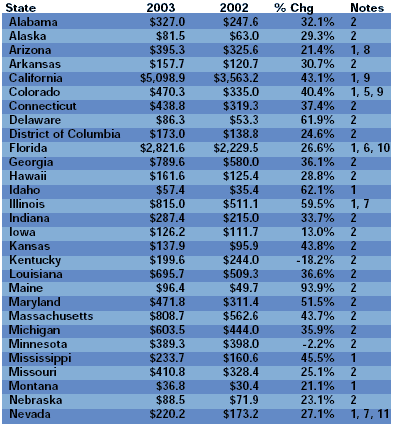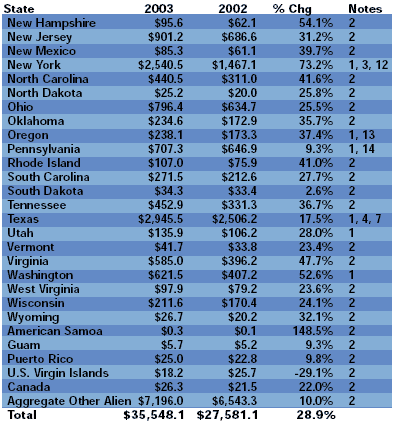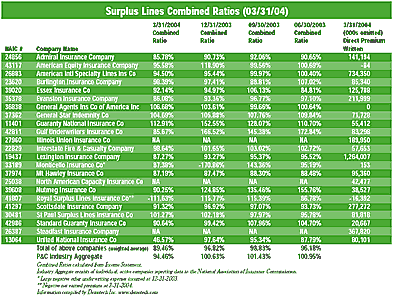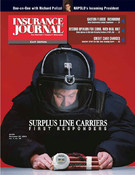Kelley Touts Innovation as Core Competitive Advantage
Lexington Insurance Co., the excess and surplus line subisidiary of the American International Group, has been the leader in the domestic E&S market for decades now. The company has leveraged its astounding financial backing (an “A++” rating from A.M. Best, just to use one measure) to position itself as an innovator in the industry. Lexington CEO Kevin H. Kelley took time to talk with Insurance Journal about the market cycle, the tort system, and how to balance product innovation with stability. He spoke with us before Hurricanes Charley and Frances hurled across the Southeastern United States.
Insurance Journal: As of June 2004, MarketScout.com reported “steady” average property/casualty premium growth of 7 percent, certainly a far cry from the peak of the recent hard market. Of course, some segments are softening more quickly than others. What kind of impact does the market cycle have on Lexington’s strategy?
Kevin Kelley: We’re not surprised by anything. We would agree that probably the overall growth in the P/C industry is 7 to 8 percentage points. That seems to be the revenue numbers we’re seeing out of the major brokers. In terms of softening, you have to put it in perspective. In property, we’ve seen rate increases since 1999. That rates are being lowered there is not surprising. We are headed into wind season, and a wind event or geopolitical event could change that very abruptly. Our goal is to make an underwriting profit. To the extent that the market doesn’t allow us to do that, we’ll cut our exposure to the market. We haven’t seen any lines where that is necessary. …
The practice [of cash-flow underwriting] itself is one that’s never led to success. Those companies that have focused on rates declining have had to adjust at some point, and it came too late for policyholders. A great example of that is Reliance. So it’s not a great strategy, but that’s what makes markets. We don’t control the markets. We have to respond to opportunities within it. That’s the risk we’re taking. I think what policyholders need to focus on is the financial security of some of those carriers. They need to ask themselves, “Why are they [lowering rates]?” The balance-sheet issues are still out there. Some carriers are attempting to do some short-term fixes to rectify balance-sheet issues. That’s very dangerous.

IJ: Another feature of the hard market was appetite. In certain segments, any risk with a loss was forced into the surplus market. Do you sense that there is now greater appetite from standard market insurers for riskier business?
Kelley: I think in general, yes. What you’re seeing is a desire to move market share by some of the standard markets. So this is true for them. It’s true for some in the Bermuda market as well as the nonadmitted market. There’s much more of a focus on pushing market share. That’s not a strategy we’re going to employ. Our chief concern at this stage is adverse selection. We want to make sure we’re seeing good business. One of the tactics we’re employing is initiatives that allow us to see a broad array of business in particular industries and because of our flexibility, we have the ability to design products to meet those unique needs.

IJ: When we spoke last year you said that Lexington’s fastest-growing segment was program business, ahead by 85 to 90 percent. Are you still seeing that kind of growth, and if so what market conditions make program business so attractive right now?
Kelley: The reason why it’s attractive is because there are a lot of barriers to entry. Not a lot of carriers understand consequences of it. You can design some products a little better, that are highly focused and that customers are willing to pay a little bit more for as a package that exists right for their industry. The mistake a lot of carriers make is that business is managed the same way as the rest of their business. They need the technology in order to handle the business. If you don’t have that, you’ll fail.
IJ: You’ve mentioned before that you don’t see other surplus line carriers as Lexington’s primary competition. In the property market, for example, you said that you’re most often in competition with FM Global. Do you think the gray area between the standard and surplus markets is growing and if so why?
Kelley: That’s very possible that there’s more gray than black and white. I would tend to look at markets as not necessarily between standard and surplus lines. I’d look at London as a market, Bermuda as a market, nonadmitted U.S. carriers as a market and then everyone else. Our view of the world is pretty simple. We built this company around two main points. One, should there be a major event in the industry, we want to be in a position to pay our claims in a fair and efficient manner. Two, we want to make a market post-event. The World Trade Center was probably our great but unfortunate example of that. We made a market the day after. We were trying to figure out what it all meant. So a tool to do that is our nonadmitted status that gives us flexibility.
We tend to look at the commercial market, principally the Fortune 2,000, and the middle market in program business. We don’t think that market has any problem with us. I don’t even know that they always are aware that we’re nonadmitted. I think if there’s any issue it probably is, and it should be, company specific as opposed to admitted versus nonadmitted.
Look at the companies that have had problems—all admitted. It’s not necessarily the choice of nonadmitted or standard. It’s about good, solid financial analysis. Looking at the financial strength ratings is important, but even more important is looking at the long-term credit rating. That’s probably the best proxy of whether the company will be around. The credit community does independent analysis on the credibility of long-term debt offerings, which get analyzed by S&P or by Moody’s—those are an independent view. It’s a good check and balance. You might see one company that has a double-A financial strength rating and a triple-D credit rating. That’s a red flag.
IJ: In the event that the Terrorism Risk Insurance Act (TRIA) is not renewed beyond 2005, how would Lexington respond?
Kelley: We made a market for terrorism risk prior to TRIA and we still have a stand-alone risk. We would continue to have that market. What would happen if TRIA were not renewed is that there may be more demand for coverage. People today fall into a false sense of security about risk. The other thing to keep in mind is that if TRIA is renewed, it’s very likely that the company deductibles will jump from 15 percent of direct earned premium to 20 percent of direct earned premium. That’s going to put a lot of pressure on some companies. That 20 percent deductible may be 25 percent of a particular company’s surplus. You never want to expose more than 10 percent of the surplus.
IJ: Lexington introduced the Safety Act Homeland Protector this year, an example of your company’s commitment to innovative products.
Do you think product innovation is the key to surplus line carriers’ avoiding the volatility of the insurance market cycle, and if so how can an insurer innovate while simultaneously exhibiting the caution so necessary to financial stability?
Kelley: I think it’s one element of the strategy. You don’t turn that button on and off based on market cycle. Our view was that innovation is our core competitive advantage. We are always looking at new things and ways that, bottom line, we can help clients adapt to change. That’s really what we’re trying to do. industry.
IJ: How do you balance the need and clear desire for product innovation in the insurance marketplace with the reality that the nature of the business demands caution and prudence?
Kelley: This is where size comes in. I think if you’re going to be a truly great innovator, you have to have a balance sheet that allows you to take prudent risks. You have to have the resources to allow you to examine relationships that could affect your balance sheet. You can make mistakes, but you manage those mistakes so that they’re not going to have significant impacts on the company. We have a surplus position that allows us to take prudent risks, but we’re very cognizant of downside protection.
Topics InsurTech Carriers Excess Surplus Market
Was this article valuable?
Here are more articles you may enjoy.



 Howden US Tells Judge Brown & Brown Employees Fled Due to ‘Mistreatment’
Howden US Tells Judge Brown & Brown Employees Fled Due to ‘Mistreatment’  Florida Insurance Agency VP Sentenced to 3 Years in Massive ACA Fraud Scheme
Florida Insurance Agency VP Sentenced to 3 Years in Massive ACA Fraud Scheme  10 Highest Class-Action Settlements in 2025 Eclipsed $70B Total: Duane Morris
10 Highest Class-Action Settlements in 2025 Eclipsed $70B Total: Duane Morris  FBI Involved After Two Florida Injury Lawyers Go Missing From Fishing Trip
FBI Involved After Two Florida Injury Lawyers Go Missing From Fishing Trip 


